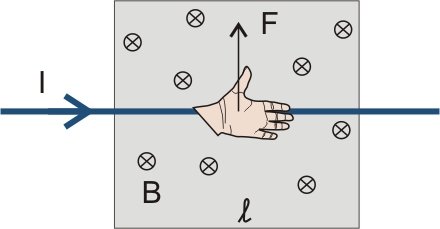Personal collections


The magnetic force  on a conductor in a magnetic field through which the electric current flows is given by the equation:
on a conductor in a magnetic field through which the electric current flows is given by the equation:

We note that the charge  can be expressed as:
can be expressed as:

where  is the current flowing through the conductor and
is the current flowing through the conductor and  is the time of flow of the current.
is the time of flow of the current.
We note also that the speed  can be expressed as:
can be expressed as:

where  is the length of the conductor located in the magnetic field.
is the length of the conductor located in the magnetic field.
If we therefore substitute equations 2 and 3 into 1, we have:

The direction of the force is determined in a similar way we determine the direction of motion of charged particles in a magnetic field, i.e., with the help of the right-hand screw rule. The curled fingers represent the magnetic field  with the current
with the current  perpendicular to it while the thumb points in the direction of the force
perpendicular to it while the thumb points in the direction of the force  .
.
Another way to determine the direction of the force is using the left-hand rule: the magnetic lines go into the palm of the left hand, the outstretched fingers are the direction of the current and the outstretched thumb is the direction of the magnetic force.

Determining the direction of the magnetic force on a current-carrying conductor using the left-hand rule
Note: A circle with a cross means the direction of the vector into the monitor (away from the observer), and a circle with a dot would mean the direction of the vector out of the monitor (towards the observer).